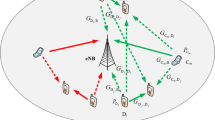Abstract
In this paper, we consider an energy harvesting device-to-device (D2D) communication system, where D2D transmitter can use mode A to directly communicate with D2D receiver or use mode B as a relay to assist cellular communication while communicating with D2D receiver by adopting non-orthogonal multiple access technology. Firstly, the outage probability expression in two modes is derived, and the communication mode is determined according to outage performance. Then, assuming that the full system information is available, the channel allocation and relay selection are completed by Kuhn–Munkres algorithm, and the offline power allocation of D2D users is realized by reinforcement learning. Next, the offline optimization results are taken as the training data set to train the neural network, and the optimal model of the transmission power is obtained. Considering the transmission power constraint, the online power allocation optimization algorithm is further proposed. Numerical results demonstrate the accuracy of derived outage probability, and the proposed resource allocation algorithm can improve the performance of hybrid system.











Similar content being viewed by others
References
Ahmed, M., Li, Y., Waqas, M., et al. (2018). A survey on socially aware device-to-device communications. IEEE Communications Surveys & Tutorials, 20(3), 2169–2197.
Jameel, F., Hamid, Z., Jabeen, F., & Javed, M. A. (2018). A survey of device-to-device communications: research issues and challenges. IEEE Communications Surveys & Tutorials, 20(3), 2133–2168.
Lee, N., Lin, X., Andrews, J. G., & Heath, R. W., Jr. (2015). Power control for D2D underlaid cellular networks: modeling, algorithms and analysis. IEEE Journal on Selected Areas in Communications, 33(1), 1–13.
Liu, S., Wu, Y., Li, L., et al. (2019). A two-stage energy-efficient approach for joint power control and channel allocation in D2D communication. IEEE Access, 7, 16940–16951.
Zhang, G., Hu, J., Heng, W., et al. (2017). Distributed power control for D2D communications underlaying cellular network using Stackelberg game. In IEEE Wireless Communications and Networking Conference (pp. 19–22).
Yin, C., Wang, Y., Lin, W., & Wang, X. (2014). Energy-efficient channel reusing for device-to-device communications underlying cellular networks. In IEEE 79th Vehicular Technology Conference (pp. 18–21).
Chang, W., & Teng, J. (2018). Energy efficient relay matching with bottleneck effect elimination power adjusting for full-duplex relay assisted D2D networks using mmWave technology. IEEE Access, 6, 3300–3309.
Waqas, M., Sidhu, G., Jabeen, T., et al. (2018). Transmit power optimization for relay-aided multi-carrier D2D communication. Tsinghua Science and Technology, 23(1), 65–74.
Ku, M., Li, W., Chen, Y., & Liu, K. J. R. (2016). Advances in energy harvesting communications: Past, present, and future challenges. IEEE Communications Surveys & Tutorials, 18(2), 1384–1412.
Ma, B., Zhang, H., & Zhang, Z. (2015). Joint power allocation and mode selection for D2D communications with imperfect CSI. China Communications Journal, 12(7), 73–81.
Luo, Y., Hong, P., Su, R., & Xue, K. (2017). Resource allocation for energy harvesting-powered D2D communication underlaying cellular networks. IEEE Transactions on Vehicular Technology, 66(11), 10486–10498.
Saleem, U., Jangsher, S., Qureshi, H. K., & Hassan, S. A. (2018). Joint subcarrier and power allocation in the energy-harvesting-aided D2D communication. IEEE Transactions on Industrial Information, 14(6), 2608–2617.
Kuang, Z., Liu, G., Li, G., & Deng, X. (2018). Energy efficient resource allocation algorithm in energy harvesting-based D2D heterogeneous networks. IEEE Internet of Things Journal, 6(1), 557–567.
Luo, Y., Hong, P., & Su, R. (2017). Energy-efficient scheduling and power allocation for energy harvesting-based D2D communication. In IEEE Global Communications Conference (pp. 4–8).
Sujesha, S., & Kulkarni, P. (2011). Energy harvesting sensor nodes: Survey and implications. IEEE Communications Surveys & Tutorials, 13(3), 443–461.
Gupta, S., Zhang, R., & Hanzo, L. (2017). Energy harvesting aided device-to-device communication underlaying the cellular downlink. IEEE Access, 5, 7405–7413.
Yu, B., & Zhu, Q. (2016). A QoS-based channel allocation and power control algorithm for device-to-device communication underlaying cellular networks. Journal of Communications, 11(7), 624–631.
Laneman, J., Tse, D. N. C., & Wornell, G. W. (2004). Cooperative diversity in wireless networks: Efficient protocols and outage behavior. IEEE Transactions on Information Theory, 50(12), 3062–3080.
Kami, S., Tran, N., Ho, T., et al. (2018). Coordinated device-to-device communication with non-orthogonal multiple access in future wireless cellular networks. IEEE Access, 6, 39860–39875.
Gradshteyn, I. S., & Ryzhik, I. M. (2007). Table of integrals, series, and products. San Diego: Academic Press.
Papadimitriou, C. H., & Steiglitz, K. (1988). Combinatorial optimization: Algorithms and complexity. New York: Dover Publications.
Feng, D., Lu, L., Wu, Y., et al. (2013). Device-to-device communications underlaying cellular networks. IEEE Transactions on Communication, 61(8), 3541–3551.
SuttonR, S., & Barto, A. G. (1998). Reinforcement learning: An introduction. Cambridge: MIT Press.
Sigaud, O., & Buffet, O. (2010). Markov decision processes in artificial intelligence. Hoboken: Wiley.
Watkins, C. J. C. H. (1989). Learning from delayed rewards. Ph.D. Dissertation, London University, London, England.
Haykin, S. (2001). Neural networks: A comprehensive foundation. Delhi: Personal Education.
Hornik, K., Stinchcombe, M., & White, H. (1989). Multilayer feedforward networks are universal approximators. Neural Networks, 2(5), 359–366.
Funding
This work was supported by National Natural Science Foundation of China under Grant Nos. 61971239 and 61631020.
Author information
Authors and Affiliations
Corresponding author
Additional information
Publisher's Note
Springer Nature remains neutral with regard to jurisdictional claims in published maps and institutional affiliations.
Rights and permissions
About this article
Cite this article
Su, N., Zhu, Q. Outage performance analysis and resource allocation algorithm for energy harvesting D2D communication system. Wireless Netw 26, 5163–5176 (2020). https://doi.org/10.1007/s11276-020-02386-0
Published:
Issue Date:
DOI: https://doi.org/10.1007/s11276-020-02386-0




